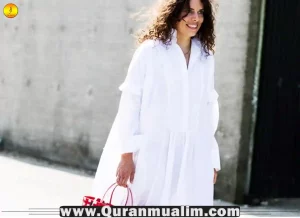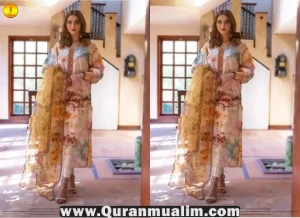OBSERVING HIJAB DURING MEDICAL TREATMENT
In the Shari‘a, the hijab is a perpetual obligation which must be observed under any and all circumstances including during medical treatment. Jóbir g narrates:
. عن جابر رضى الله عنه أن أم سلمة رضى الله عنها إستاذنت رسول الله صلى الله عليه وسلم فى الحجامة فأمر أبا طيبة أن يحجمها قال حسبت أنه كان أخاها من الرضاعة أو غلاما لم يحتلم
Once Umm Salama j asked permission from the Blessed Prophet s for bloodcupping [úijóma]. (Cupping-The application of a cup shaped instrument to the skin to draw blood for the purpose of bloodletting.)The Blessed Prophet s asked Abñ ùaiba to cup Umm Salama j. Jóbir g said, “I think the Blessed Prophet s asked Abñ ùaiba to cup Umm Salama j because he was either her foster brother or a prepubescent boy. (Muslim, likulli Dó’in Dawó’un)
This hadith points out that hijab is necessary even during medical treatment, otherwise Jóbir g would have not needed to clarify that Abñ ùaiba was Umm Salama’s foster brother or a prepubescent boy.
In this day and age, even religious families which are otherwise strict in matters of hijab, become careless in observing hijób while seeking medical treatment. The above hadith proves that one should find a maúram if possible for medical treatment otherwise a non-maúram may provide treatment as well.
TO UNCOVER SATR FOR MEDICAL TREATMENT
![Write observing Hijab during medical treatment? Special circumstances examples, to ignore, examples of assumptions in life and quranmualim. Learn Quran, Quran translation, Quran mp3,quran explorer, Quran download, Quran translation in Urdu English to Arabic, Al Mualim, Quranmualim, Vislam pictures, Islam symbol, Shia Islam, Sunni Islam, Islam facts],Islam beliefs and practices Islam religion history, Islam guide, prophet Muhammad quotes, prophet Muhammad biography, Prophet Muhammad family tree](https://www.quranmualim.com/wp-content/uploads/2019/06/Write-observing-Hijab-during-medical-treatmentB.jpg)
It is permissible to uncover satr for medical reasons but only as much as is absolutely necessary according to the following principle of Shari‘a:
الضرورة تقدر بقدرالضرورة
A necessity is allowed to the extent of necessityFor example, if the physician can suffice with checking the pulse and asking about the symptoms, he will not be permitted to touch or see anything. Similarly, if the arm or ankle is wounded, he may see only the arm or ankle. If he needs to examine the eyes, nose or mouth, then only that part may be uncovered and not the entire face. These restrictions will also apply to a physician who is a maúram of the patient since he is also not allowed to look at the body of a maúram woman. She is not permitted to uncover her back, her front, or her thighs even in front of the maúórim. Therefore, if the wound is in such an area, the physician may only examine that much area only, regardless of whether he is a maúram or not. This may be accomplished by wearing old clothes with a hole cut in the area of the wound. Since a woman is not permitted to uncover any parts of her body between the navel and the knees in front of other women, therefore, a lady physician will only be permitted to examine the affected areas through openings that accommodate those areas. It should also be remembered that while the physician is examining the patient, any relatives present at the time are not permitted to observe those parts, except for one who is lawfully permitted to see them. For example, the father and brother may see the ankle during the physical examination as it is not forbidden for a maúram to observe the ankle of a maúram woman.
It should be clearly understood that all the above rulings apply to the medical treatment of men also since it is not permitted for men to uncover their body parts between the navel and the knee in front of other men. Therefore, if the physician needs to examine a man’s buttocks or give an injection in that area he is only permitted to see as much as is absolutely necessary.
HIJAB IN IûRĀM
The importance of hijab in the Shari‘a is such that a woman is required to observe hijab even in the state of iúróm.
عن عائشة رضى الله عنها قالت كان الركبان يمرون بنا ونحن مع رسول الله صلى الله عليه وسلم محرمات فإذا حاذوا بنا سدلت إحدانا جلبابها من رأسها إلى وجهها فإذا جاوزونا كشفناه
‘ô’isha j narrates, “We were with the Blessed Prophet s in the state of iúróm [during hajj]. When men passed by us, we pulled our shawls in front of our faces; and when they passed us, we lifted them off. ( Abñ Dówñd, fi al-Mar’ati Tughaøøī Wajhahó | al-Baihaqī, al-Muúrima Talbisu al-Thaub)
Due to ignorance, many people believe that hijab is not necessary in the state of iúróm since it is not permissible to have clothes or anything else touch the face while one is in iúróm. Such assumptions are based on ignorance as the above hadith is clear that hijab is necessary even in the state of iúróm. However, the way of observing hijab in iúróm is slightly different. One way, for example, is that the woman wear a hat with a projected flap by which the veil hangs over her face and does not touch it [hijab is observed in this way by a number of women in the state of iúróm]. The wives of the Blessed Prophet s also covered their faces with their shawls in front of non-maúram men during iúróm.
A similar hadith is narrated by Fóøima bint Mundhir . She says: We would cover our faces with our shawls in the state of iúróm. Asmó’ the daughter of Abñ Bakr g, was also with us and she did not stop us from this. ( al-Muwaøøa’, Takhmīr al-Muúrim Wajhahñ)
In other words, Asmó’ j never rebuked them for covering their face in iúróm saying it was forbidden [for a woman to cover her face in the state of iúram]. In another hadith, ‘ô’isha narrates that a woman should hang her shawl in front of her face in the state of iúróm. ( Fatú al-Bórī, Mó Yunhó min al-ùīb)
IMPORTANCE OF HIJAB WITH IN-LAWS
People living in the same home often become so inured to each other that the rules of Shari‘a never cross their mind in this regard. Therefore, it is often seen that hijab is not observed with the brothers-in-law, though much emphasis is laid on observing hijab from them.
عن عقبة بن عامر رضى الله عنه قال قال رسول الله صلى الله عليه وسلم إياكم والدخول على النساء فقال رجل يا رسول الله أرأيت الحمو قال الحمو الموت
‘Uqba ibn ‘ômir g narrates, “The Blessed Prophet s once said, ‘do not go near non-maúram women. One man from amongst them asked him, “O Prophet of Allah, what is the command about the inlaws of a woman?” The Blessed Prophet s responded, “The [dangers in not observing hijab with] in-laws are like death.” ( Bukhórõ, ló Yakhluwanna Rajulun bi Imra’a)
The most important part of the abovementioned hadith is that the Blessed Prophet s compared the in-laws to death [i.e. that a woman must be more careful in observing hijab with her brothers-in-law]. Although a woman is required to observe hijab with all non-maúram men, she should avoid the brothers-in-law as she would avoid death and observe hijab from them.
The reason behind this ruling is that since male in-laws are considered part of the family, they freely enter and are invited into the ladies section which at times results in illict relations. It never occurs to the unassuming husband to prohibit them from his wife as he thinks them part of the family. But, if they come to his house frequently and the husband happens to be away, many unlikely things may occur. It is not as easy for a neighbor to seduce his neighbor’s wife as it is for a brotherin-law to seduce or abuse his sister-in-law.
It is for these reasons that the Blessed Prophet s strongly advised that a woman strictly observe hijab with her in-laws and to avoid the men amongst them as one avoids death. Similarly, the men are instructed not to freely mix with their sisters-in-law and to avoid gazing at them.
![Write observing Hijab during medical treatment? Special circumstances examples, to ignore, examples of assumptions in life and quranmualim. Learn Quran, Quran translation, Quran mp3,quran explorer, Quran download, Quran translation in Urdu English to Arabic, Al Mualim, Quranmualim, Vislam pictures, Islam symbol, Shia Islam, Sunni Islam, Islam facts],Islam beliefs and practices Islam religion history, Islam guide, prophet Muhammad quotes, prophet Muhammad biography, Prophet Muhammad family tree](https://www.quranmualim.com/wp-content/uploads/2019/06/Write-observing-Hijab-during-medical-treatmentC.jpg)

![What should do observing Hijab during medical treatment?Special circumstances examples, to ignore, examples of assumptions in life and quranmualim. Learn Quran, Quran translation, Quran mp3,quran explorer, Quran download, Quran translation in Urdu English to Arabic, Al Mualim, Quranmualim, Vislam pictures, Islam symbol, Shia Islam, Sunni Islam, Islam facts],Islam beliefs and practices Islam religion history, Islam guide, prophet Muhammad quotes, prophet Muhammad biography, Prophet Muhammad family tree.](https://www.quranmualim.com/wp-content/uploads/2019/06/Write-observing-Hijab-during-medical-treatmentA.png)





